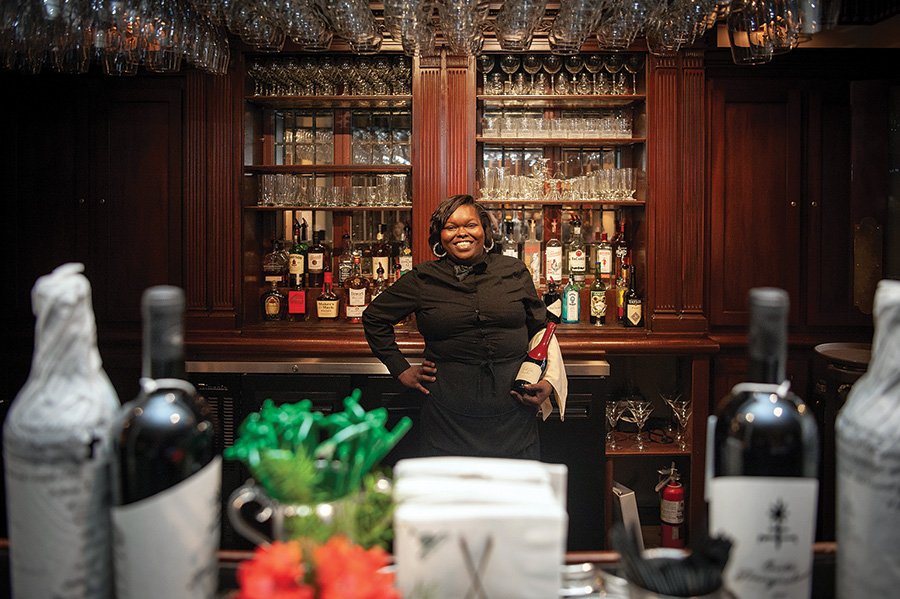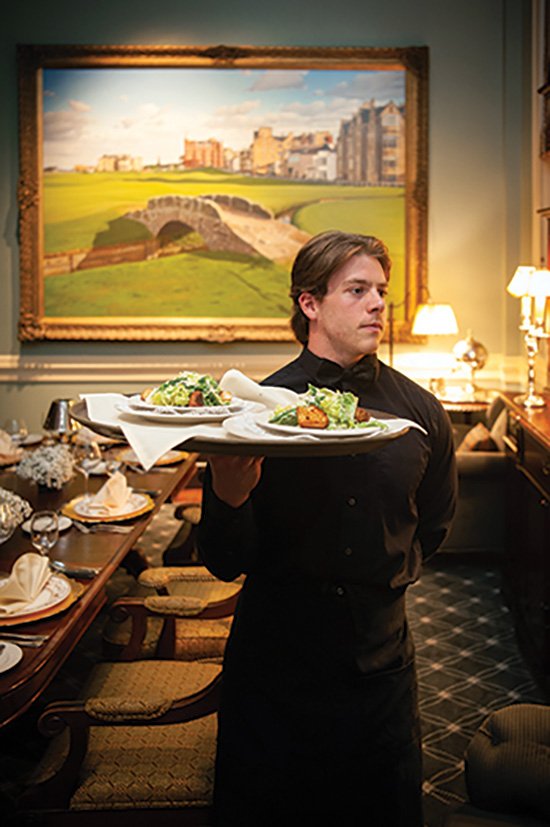Bryan's Bet

Old Waverly is an enduring legacy and an economic engine for West Point
In 1981, 12-year-old Wilkes Bryan tagged along with his dad, George Bryan, on a trip to Tiger Point Golf Club in Gulf Breeze, Florida. It was a real treat for the youngster. He got a golf lesson from Jerry Pate, an eight-time winner on the PGA Tour, including a U.S. Open and Tournament Players Championship.
“Jerry Pate gave me a lesson, then he disappeared out there somewhere with my dad,” Wilkes Bryan recalled. “I had no idea what they were talking about.”
Wilkes Bryan stands in front of a portrait of his father, George Bryan, at Old Waverly.
Only a handful of people knew what George Bryan was up to then.
For the next five years or so, George Bryan quietly worked on putting all the pieces together for an improbable dream – building a world-class golf course on a 360-acre parcel in West Point he purchased from his brother-in-law, Robert Harrell.
When word finally got out what he was planning, most people were skeptical. Some were incredulous.
“I remember a lot of people saying dad was crazy,” Wilkes Bryan said.
“I’ll be honest: A lot of people didn’t like it,” said Robbie Robinson, who was the Clay County chancery clerk at the time and would go on to become a two-term mayor of West Point. “They thought golf was a rich man’s game and we’re all poor people around here. Why should we care?”
“I remember George picking me up one Sunday afternoon and taking me out there to explain what he wanted to do,” said Lee Stafford, Bryan’s friend and accountant, “I’ve never been the kind of person to ridicule a friend’s dream, but I just didn’t know about it. I listened and agreed to assist him, purely on the basis of our friendship.”
Residences border a lake at Old Waverly.
The story of Old Waverly Golf Club defies reason. It exists as a testament to the extraordinary vision, bull-headed determination and inescapable charisma of one man.
George Bryan died Jan. 6 at his home at Old Waverly at age 78. His impact, expressed through his greatest achievement, lives on to the benefit of the entire community, even those who have never set foot on the Old Waverly property.
“It’s hard to imagine what West Point would be like now if George hadn’t decided to build that golf course here in his hometown,” Robinson said.
An improbable dream
It’s not uncommon for golf courses to spring up in little towns across the country.
But something on the scale of Old Waverly is an outlier, the kind of an upscale golf experience rarely found in a location that isn’t adjacent to a major population center or in an established resort area.
West Point’s population at the time Old Waverly opened was just 8,778. The closest cities with a population of more than 200,000 were Birmingham (132 miles away) and Memphis (162 miles). The closest resort area is the Mississippi Gulf Coast, 250 miles to the south.
Jim Gallagher Jr. has spent more than 40 years at golf courses all over the country, first as a PGA Tour player (five career wins) and, since 2014, as an analyst for the Golf Channel.
In a particular way, Old Waverly stands apart.
“When you’re coming up the driveway there and you see this beautiful clubhouse, all the buildings, the golf course itself, you think, ‘Where am I? Is this Mississippi? How can that be?’” Gallagher said. “Then, a little later, you see that the U.S. Women’s Open (1999) is being played here. How? That just doesn’t happen.”
Putting together the pieces
To finance the project, George Bryan turned to his friends for support, in the form of a Founder’s Group, each of whom committed to buying a $30,000 lot on the property.
“He knew it would be good to have some people on his side,” Wilkes Bryan said.
That $900,000 covered only a portion of the investment needed, Wilkes Bryan said. “In those days, I think the cost turned out to be around $4.5 million.”
George Bryan funded the remaining $3.6 million through his own assets and through the sale of remaining 50 or so home lots on the property.
For the golf course, he turned to Pate, who at the time of the Bryans’ 1981 visit to Florida, was winding down his playing career and looking to get into course design, working with Bob Cupp, a golf course designer who had worked with golf legend Jack Nicklaus on numerous courses.
For the architecture of clubhouse and other buildings, Bryan found a connection closer to home, West Point native Roger Pryor, whose architecture career was just getting started.
“I had just come back from graduate school at the University of Pennsylvania and I had a special interest in historic preservation,” Pryor said. “George was interested in two things – a level of historical authenticity and a continuity of that style in all the buildings. Obviously, it was an an enormous opportunity for me as a young architect.”
Pryor said he was sold on the project from the moment Bryan approached him with his plan.
“I saw it immediately,” Pryor said. “He had a sophistication about him. He had been around the block. He knew good architecture when he saw it.”
Pryor worked with another West Point native, interior designer Steve Bengel.
They quickly learn two things: First, Bryan believed in quality. Second, he was no push-over.
“I’ll tell you something about George and the Byrans: They know the value of a dollar,” Pryor said. “There wasn’t a carte blanche budget on anything. He wanted quality, but if you didn’t give him a good value on the dollar you were out of there.”
A bigger circle
The insistence on quality wasn’t just a personal pride for Bryan. It was strategic.
Old Waverly opened in 1989 before the large industries – and the executives who were potential club members – arrived.
Dinner is served in the Old Waverly clubhouse.
“Sara Lee (which purchased Bryan Foods in 1968) was still roaring then and they were a big help,” Wilkes Bryan said. “I think we got 26 members from them, but we obviously needed to reach out.”
To build that membership, Bryan relied heavily on the network of friends he had built throughout the state and in places like Memphis and Birmingham.
“Businesses draw a circle, a radius that they rely on for customers,” Wilkes Bryan said. “For us, that circle just kept getting bigger and bigger.”
“George knew the top business executives all over the world and they respected him,” Gallaghere said. “He could tell you the amount of cars that went up and down Highway 45. He knew everything there was to know about his business.”
Wilkes Bryan said Old Waverly now has almost 800 members from 30 states and seven countries.
“We’re built out on home lots,” Wilkes Bryan said. “We may have an odd lot here and there, but for the most part, all the home lots are taken.”
More than a golf destination
Old Waverly has been ranked among Golf Digest’s Top 100 golf Courses in the United States six times. It has been host to two of the most prominent events in women’s golf – the U.S. Women’s Open (1999) and the U.S. Women’s Amateur (2019). It hosted the HANDA Cup, a Ryder Cup-style event featuring senior women players in a U.S. vs. the World matchup.
Its sister course, Mossy Oak, which opened in 2016 and was ranked as Golf Digest’s the third best new golf course in the U.S. when it opened. Mossy Oak is the home to both the Mississippi State mens and women’s golf programs as well as the home course for the state’s top junior golf program.
Golfers play the course at Old Waverly.
Old Waverly’s place in the world of golf is well-established, but to the people of West Point, its significance goes far beyond the game.
“You can’t just look at it as a golf course,” said Stafford, who as an accountant understands the broader impact of the property. “It’s also a retirement community and, for a lot of people, the home they have at Old Waverly is not their primary home, that means they’re not claiming homestead on those houses. They’re paying the full tax.”
“Put it this way, Old Waverly is 3 percent of the population paying 13 percent of the taxes,” Wilkes Byran said. “Then, you think of all the businesses here affected by the people at Old Waverly who are buying gas, groceries, eating in restaurants and shopping at all kinds of businesses. Old Waverly has a pretty big economic footprint.”
Residences under construction at Old Waverly.
Tax income from the city on the property owned by the club and its facilities are no small figure.
“We just paid $460,000 in city taxes in November,” Wilkes Bryan said. “Put it all together and Old Waverly has been a gold mine for the city.”
“I shudder to think where West Point would be without Old Waverly,” Stafford said. “It has softened the blow in the tough times (when Sarah Lee closed West Point operations in 2007, costing 1,200 workers their jobs) and is a source of pride not just for West Point, but for the larger community of the Golden Triangle.”
Gallagher lives in Greenwood, but has a second home at Old Waverly.
“George Bryan did more for golf in Mississippi than anyone who has ever lived,” Gallagher said. “Anyone who knows me, knows I”m going to be talking about George and what he did at Old Waverly at some point,” he said. “It’s incredible.”
STORY BY SLIM SMITH
ALL OTHER PHOTOS BY RORY DOYLE











